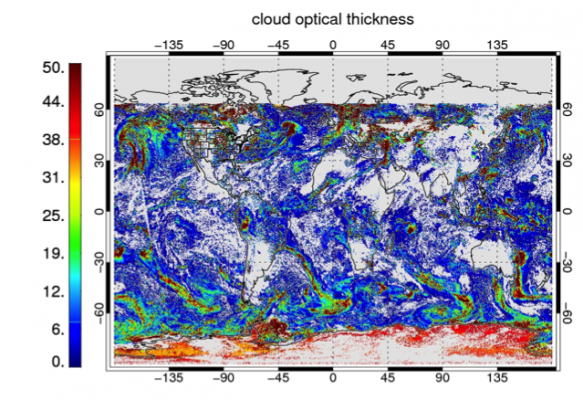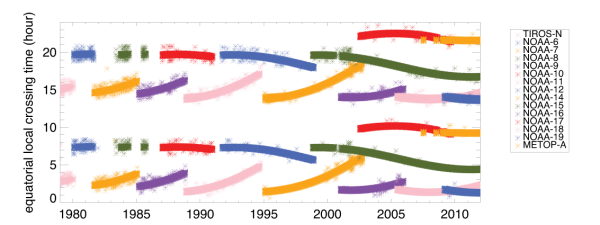Milestone delivery: Cloud properties dataset to NCDC
Earlier this year a team of National Oceanic and Atmospheric Administration (NOAA) and Cooperative Institute for Meteorological Satellite (CIMSS) scientists reached a major milestone by delivering an operational PATMOS-x (Pathfinder Atmospheres Extended) cloud properties Climate Data Record (CDR) to the National Climatic Data Center (NCDC).
The team followed a rigorous process to comply with NCDC’s requirements for submitting a CDR. This new CDR consists of a consistent, long-term series of cloud property observations derived from Advanced Very High Resolution Radiometer (AVHRR) data from the Polar-orbiting Operational Environmental Satellites (POES) extending back to 1978. The cloud properties include cloud-top height, cloud-top temperature, cloud-top pressure, cloud optical depth, and cloud particle size.

Example of a PATMOS-x 0.1º level-2b cloud product (optical depth) viewed globally over a single day.
Led by NOAA scientist Andrew Heidinger of the Advanced Satellite Products Branch (ASPB), a team of CIMSS researchers and programmers contributed to the project. Andrew Heidinger and Andi Walther developed the scientific algorithms, Denis Botambekov handled validation and quality control, Mike Foster was tasked with turning the Level 2 data into Level 3 data, as well as managing the reporting and documentation, while Mike Hiley handled the processing.
Producing a dataset for NCDC’s CDR Program requires following a set of precise guidelines. First and foremost, the dataset needs to be long-term — 30+ years — and stable.
“The great thing about PATMOS-x is that it’s a very long time series. For a climate record, we need this long-term data. And we could prove through publications that the time series is stable enough to be seen as a climate data record,” Walther said.
Publishing peer-reviewed articles to establish the dataset as stable and suitable for a CDR is just one component of the CDR process, which also included completing a maturity matrix and undergoing validation. The end goal is to ensure that the dataset could be used in climate applications. With its successful delivery of a CDR, this NOAA/CIMSS team has achieved something quite unique.
“We are one of a handful of multi-decadal satellite climate records in the world,” noted Walther.
Heidinger added that, prior to the PATMOS-x delivery, the International Satellite Cloud Climatology Project (ISCCP) dataset had been the main long-term cloud data record available.
While preparing the CDR, the team relied on prior experience working with NCDC, specifically their 2010 delivery of calibrated AVHRR reflectances. This new dataset, however, is a significant extension of that prior delivery.
“The big step for us this time was that we actually have our cloud products submitted, the things that we derive ourselves,” commented Foster, adding that this new CDR allows for a near real-time generation capability.
“For the first time, you can get up to within a four-to-five-day latency the entire PATMOS-x cloud record, which is nice for climate monitoring applications,” he remarked.
This work complements research for which CIMSS and the Space Science and Engineering Center (SSEC) are already well known.
“We really are a center of satellite climate datasets,” noted Heidinger, highlighting the cloud climatology from SSEC’s Paul Menzel and Don Wylie and polar cloud work from ASPB’s Jeff Key.
As the team learned, creating the CDR at SSEC had certain benefits. Heidinger specifically called out the importance of computing resources available at SSEC that offered the ability to reprocess the data as needed. Walther echoed Heidinger’s comment, also noting how the vast improvements in computing speed and memory over the last decade have made their work significantly easier.
In fact, it was just over a decade ago when the initial work on this project began. Heidinger related how small, pilot projects through NOAA’s Office of Research and Applications led to connections with the Global Energy and Water Cycle Experiment (GEWEX) research program. Participating in GEWEX brought opportunities to begin the process of comparing and validating their dataset. In 2006 Heidinger and his team formally proposed the creation of the CDR. In addition to those named above, many NOAA and CIMSS scientists, including Mike Pavolonis, Christine Molling and William Straka, contributed to the PATMOS-x project over the years.

Time range and equatorial crossing time of the NOAA and MetOp polar-orbiting satellites that comprise the PATMOS-x/AVHRR record.
With this CDR delivery behind them, the team is forging ahead on a number of related projects. With funding from NCDC, they are beginning year two of a three-year project to develop a merged AVHRR + HIRS (High resolution Infrared Radiation Sounder) record. Foster noted that “we have initial files with HIRS and AVHRR measurements collocated and we’ve already gotten some really interesting results.”
“We certainly know HIRS + AVHRR is better than AVHRR alone,” Heidinger added.
Heidinger described this project, which combines the records of an imager and a sounder, as a way to get “a common channel base going back to the early 1980s.” This would improve the consistency of the dataset, which is once again essential to climate applications.
Heidinger is hopeful that his team will be able to complete the requirements to deliver this new dataset as a CDR to NCDC in the future.
Other extensions of the PATMOS-x record include Botambekov’s efforts to incorporate VIIRS measurements — thereby broadening the number of polar sensors covered. There are also plans to make use of the SSEC Data Center GOES archive to develop a PATMOS-x GOES dataset; Heidinger noted they are preparing this geostationary dataset in a way that it could also become a CDR available through NCDC.
In the meantime, NOAA’s Center for Satellite Applications and Research (STAR) has funded a CIMSS climate data portal. This portal will allow the team to make its experimental datasets available — datasets not available through NCDC. Eventually, Heidinger would like to see the portal as a place where they could host all of their climate datasets.
Heidinger made it clear that their work is far from over. There is still much to learn from “these old sensors,” as he noted some might describe them, whether it is finding better ways to extract information or taking the datasets and applying them to climate research, an area in which they are playing a role as well.
“We’re not just data providers. We dabble as much as we can into climate analysis. We’re part of the climate research community, too,” Heidinger said.
Heidinger touted the expertise of his team, describing how their experiences, particularly with work on GOES-R and JPSS, have prepared them for the challenges ahead.
“Because of those programs, we’ve processed [the data from] just about every [active or planned] polar or geostationary imager,” he said. “So we’re in a good position to extend our climatology records.”
by Leanne Avila
For more information on the recent PATMOS-x cloud properties CDR, see this recent article by Heidinger et al.:
, Andrew K., , , , 2014: The Pathfinder Atmospheres–Extended AVHRR Climate Dataset, Bulletin of the American Meteorological Society, 95, pp. 909-922.
